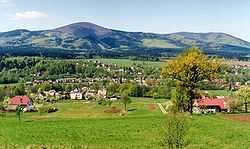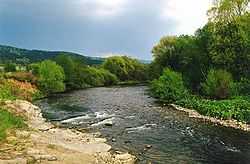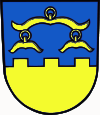Hrádek (Frýdek-Místek District)
| Hrádek Gródek | |||
|---|---|---|---|
| Village | |||
 | |||
| |||
 | |||
| Coordinates: 49°36′47″N 18°44′35″E / 49.61306°N 18.74306°E | |||
| Country | Czech Republic | ||
| Region | Moravian-Silesian | ||
| District | Frýdek-Místek | ||
| First mentioned | 1577 | ||
| Government | |||
| • Mayor | Robert Borski | ||
| Area | |||
| • Total | 9.79 km2 (3.78 sq mi) | ||
| Elevation | 353 m (1,158 ft) | ||
| Population (2006) | |||
| • Total | 1,775 | ||
| • Density | 180/km2 (470/sq mi) | ||
| Postal code | 739 97 | ||
| Website | http://www.obechradek.cz/ | ||
![]() Hrádek (help·info) (Polish: Gródek , German: Grudek) is a village in Frýdek-Místek District, Moravian-Silesian Region of the Czech Republic, on the Olza River. It has a population of 1,756 (2001 census), 42.8% of whom are Poles,[1] the highest percentage of all municipalities in the country. The village lies between the mountain ranges of the Silesian Beskids and the Moravian-Silesian Beskids, in the historical region of Cieszyn Silesia.
Hrádek (help·info) (Polish: Gródek , German: Grudek) is a village in Frýdek-Místek District, Moravian-Silesian Region of the Czech Republic, on the Olza River. It has a population of 1,756 (2001 census), 42.8% of whom are Poles,[1] the highest percentage of all municipalities in the country. The village lies between the mountain ranges of the Silesian Beskids and the Moravian-Silesian Beskids, in the historical region of Cieszyn Silesia.
The beginnings of the village can be traced back to the 12th century, when a small fort was built on a trade route running through the Jablunkov Pass. A settlement grew up around the fort. The small fort and its neighboring settlement were completely destroyed by the Magyars in 1447. Gródek was first mentioned in a written document in 1577. The village began to develop more briskly at the end of the 18th century, when about 900 people working mainly in agriculture lived there. After 1880 sandstone was exploited; its exploitation lasted until the outbreak of World War I.
According to the Austrian census of 1910 the town had 886 inhabitants, 870 of whom had permanent residence there. The census asked people for their native language, 854 (98.1%) were Polish-speaking. The most populous religious groups were Protestants with 663 (74.8%) followed by Roman Catholics with 221 (24.9%).[2]
After the division of Cieszyn Silesia in 1920, the village became part of Czechoslovakia. Following the Munich Agreement, in October 1938, Hrádek and the whole Zaolzie region were annexed by Poland. The village was then annexed by Nazi Germany at the beginning of World War II. After the war it was restored to Czechoslovakia.
There is a legend connected with the ancient fort. Notable local landmark Skała Bełki (Bełko Rock) is supposed to be the place of death of the infamous legendary knight Bełko, who plundered merchants and murdered people. According to one version, he committed suicide when his conscience overwhelmed him; according to the second version, he fell down with his horse into the Olza River chasing a mirage of victims of his cruelty.
-

Olza River in the village
-

Skała Bełki (Bełko Rock)
-

Old wooden house (drzewiónka)
-
Lutheran Church
People
- Władysław Młynek - Polish poet and writer, was born here
Footnotes
- ↑ "2001 census data". Czech Statistical Office.
- ↑ Ludwig Patryn (ed): Die Ergebnisse der Volkszählung vom 31. Dezember 1910 in Schlesien, Troppau 1912.
References
- Cicha, Irena; Kazimierz Jaworski, Bronisław Ondraszek, Barbara Stalmach and Jan Stalmach (2000). Olza od pramene po ujście. Český Těšín: Region Silesia. ISBN 80-238-6081-X.
External links
| Wikimedia Commons has media related to Hrádek (Frýdek-Místek District). |
- (Czech) Official website
| ||||||||
| |||||||||||||||||||
Coordinates: 49°36′47″N 18°44′35″E / 49.61306°N 18.74306°E




